Wednesday, July 21, 2010
détruit
Today I have considered the notion of the destruction of artworks. Many of the artists with whom I have become intimate have several, if not a great many, paintings or sculptures which they themselves chose to destroy. Happily, some remnants survive in sketch form or are described by contemporary critics but this is not always the case. Common reasons cited for committing such acts include a complete stylistic shift, scathing reviews in the press, or random bouts of fury. This is a mentality I cannot grasp. Why would someone want to obliterate their past? Perhaps I am too sentimental; perhaps they were without hope of better days to come in which they could look back and see their lives' progression.
Over a century and a half later these works have been forgotten while other pieces -pastels, maquettes, sketches - live on in gilded frames on hallowed walls. Would my dear artists consider this a success? Would they regret their past destruction seeing now how it could have added to our modern understanding? Would they embrace modern, temporary art which is designed to eventually disappear?
Monday, July 12, 2010
the value of art
"The value and rank of every art is in proportion to the mental labour employed in it, or the mental pleasure produced by it."
Sir Joshua Reynolds, Fourth Discourse, December 10, 1771
Wednesday, July 7, 2010
out-courbeted
I cannot help but swoon over delicious quotes that I uncover while pouring over newspapers of the past. Though few may grasp it (which leads me to wonder how many did at the time of the publication...) I will share it anyway. The following is from a review on an exhibition in London by the Society of French Artists in The Times, April 27, 1874:
"Manet is a conspicuous representative of the school in figure painting.
In what his admirers, we suppose, would call simplicity and frankness,
he far out-Courbets Courbet."
Though I'm sure if one were to ask Courbet, nobody could out-Courbet him!
Friday, July 2, 2010
you and your space



top: outside the Hayward Gallery, photo - melissa
middle: 'Blind Light' at the Hayward Gallery, photo- antonygormley.com
bottom: 'Event Horizon' Madison Square Park (look up!), photo - James Ewing
Though it is not the first installation of this type he has erected, British artists and 1981 Turner prize winner Antony Gormley is treating New Yorkers to an extraordinary treat this summer. In the blocks surrounding Madison Square Park, passers-by are invited to look around, and up, to engage with the 31 Gormley-sized sculptures installed on the streets and buildings. The use of such a figure, often seen in silhouette, is intriguing in a populated area where one rarely takes notice of the surrounding throngs. Once viewers begin to look, however, they can hardly stop. As Gormley himself notes: "Beyond those you can actually see, how many more remain out of sight?" (March 2010) Perception, and curiosity, is heightened through such an exercise.
The first version of 'Event Horizon' was installed in London in 2007 accompanied by the most stirring exhibition I have yet to see. Though the entire gallery was extraordinary, the namesake for the show was 'Blind Light,' pictured above. Imagine trapping a cloud and confining it in a space that is too small to let it breathe then entering that space. This is the experience of Blind Light. Inside sounds are distant, yet over the shoulder; people are separated, yet on the verge of collision. Never have I felt the intense excitement of anonymity and isolation in this way. Gormley's works, whether on or in a building, force viewers to question their own sense of space. Stand out or be anonymous? Engage or blend? To consider one's position and the position of others in the world is essentially our modern condition.
Subscribe to:
Posts (Atom)


